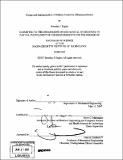| dc.contributor.advisor | Steve G. Massaquoi. | en_US |
| dc.contributor.author | Englot, Brendan J | en_US |
| dc.contributor.other | Massachusetts Institute of Technology. Dept. of Mechanical Engineering. | en_US |
| dc.date.accessioned | 2008-02-27T22:24:26Z | |
| dc.date.available | 2008-02-27T22:24:26Z | |
| dc.date.copyright | 2007 | en_US |
| dc.date.issued | 2007 | en_US |
| dc.identifier.uri | http://hdl.handle.net/1721.1/40427 | |
| dc.description | Thesis (S.B.)--Massachusetts Institute of Technology, Dept. of Mechanical Engineering, 2007. | en_US |
| dc.description | Includes bibliographical references (leaf 28). | en_US |
| dc.description.abstract | A proportional derivative control strategy was developed for the purpose of achieving balance in a humanoid robot. An artificial muscle model was adapted which modified physiological parameters for the purpose of controlling a lightweight robot skeleton. Gains were modified as a function of joint angles to permit low gain near the equilibrium point, and consequently to promote a human-like swaying behavior that is energy-efficient. The control strategy was testing by placing a non-zero initial condition on the ankle joint angle and observing the robot, both physically and in simulation, attempt to achieve a stable swaying pattern. This was achieved successfully in a simulation of the robot's mass and inertial parameters, but further efforts must be made to obtain the same behavior in the robot. The ability of a robot to successfully balance using a human-like sway pattern adds another successful biomimetic feature to humanoid robot control and in addition should improve the efficiency of such systems. | en_US |
| dc.description.statementofresponsibility | by Brendan J. Englot. | en_US |
| dc.format.extent | 28 leaves | en_US |
| dc.language.iso | eng | en_US |
| dc.publisher | Massachusetts Institute of Technology | en_US |
| dc.rights | M.I.T. theses are protected by copyright. They may be viewed from this source for any purpose, but reproduction or distribution in any format is prohibited without written permission. See provided URL for inquiries about permission. | en_US |
| dc.rights.uri | http://dspace.mit.edu/handle/1721.1/7582 | |
| dc.subject | Mechanical Engineering. | en_US |
| dc.title | Design and implementation of balance control in a humanoid robot | en_US |
| dc.type | Thesis | en_US |
| dc.description.degree | S.B. | en_US |
| dc.contributor.department | Massachusetts Institute of Technology. Department of Mechanical Engineering | |
| dc.identifier.oclc | 191699844 | en_US |
